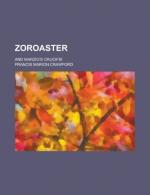She began to hate Stakhar with its splendid gardens and gorgeous colonnades, with its soft southern air that blew across the valley of roses all day long, wafting up a wondrous perfume to the south windows. She hated the indolent pomp in which she lived and the idle luxury of her days. Something in her hot-blooded Hebrew nature craved for the blazing sun and the sand-wastes of Syria, for the breath of the desert and for the burning heat of the wilderness. She had scarcely ever seen these things, for she had sojourned during the one-and-twenty years of her life, in the most magnificent palaces of the kingdom, and amid the fairest gardens the hand of man could plant. But the love of the sun and of the sand was bred in the blood. She began to hate the soft cushions and the delicate silks and the endless flowers scenting the heavy air.
Stakhar[8] itself was a mighty fortress, in the valley of the Araxes, rising dark and forbidding from the banks of the little river, crowned with towers and turrets and massive battlements, that overlooked the fertile extent of gardens, as a stern schoolmaster frowning over a crowd of fair young children. But Darius had chosen the site of his palace at some distance from the stronghold; where the river bent suddenly round a spur of the mountain, and watered a wider extent of land. The spur of the hill ran down, by an easy gradation, into the valley; and beyond it the hills separated into the wide plain of Merodasht that stretched southward many farsangs to the southern pass. Upon this promontory the king had caused to be built a huge platform which was ascended by the broadest flight of steps in the whole world, so easy of gradation that a man might easily have ridden up and then down again without danger to his horse. Upon the platform was raised the palace, a mighty structure resting on the vast columned porticoes and halls, built entirely of polished black marble, that contrasted strangely with the green slopes of the hills above and with the bright colours of the rose-gardens. Endless buildings rose behind the palace, and stretched far down towards the river below it. Most prominent of those above was the great temple of Auramazda, where the ceremonies were performed which gave Darius so much anxiety. It was a massive, square building, lower than the palace, consisting of stone walls surrounded by a deep portico of polished columns. It was not visible from the great staircase, being placed immediately behind the palace and hidden by it.
[Footnote 8: Istakhar,
called since the conquest of Alexander,
Persepolis.]
The walls and the cornices and the capitals of the pillars were richly sculptured with sacrificial processions, and long trains of soldiers and captives, with great inscriptions of wedge-shaped letters, and with animals of all sorts. The work was executed by Egyptian captives; and so carefully was the hard black marble carved and polished, that a man could see his face in the even surfaces, and they sent back the light like dark mirrors.




